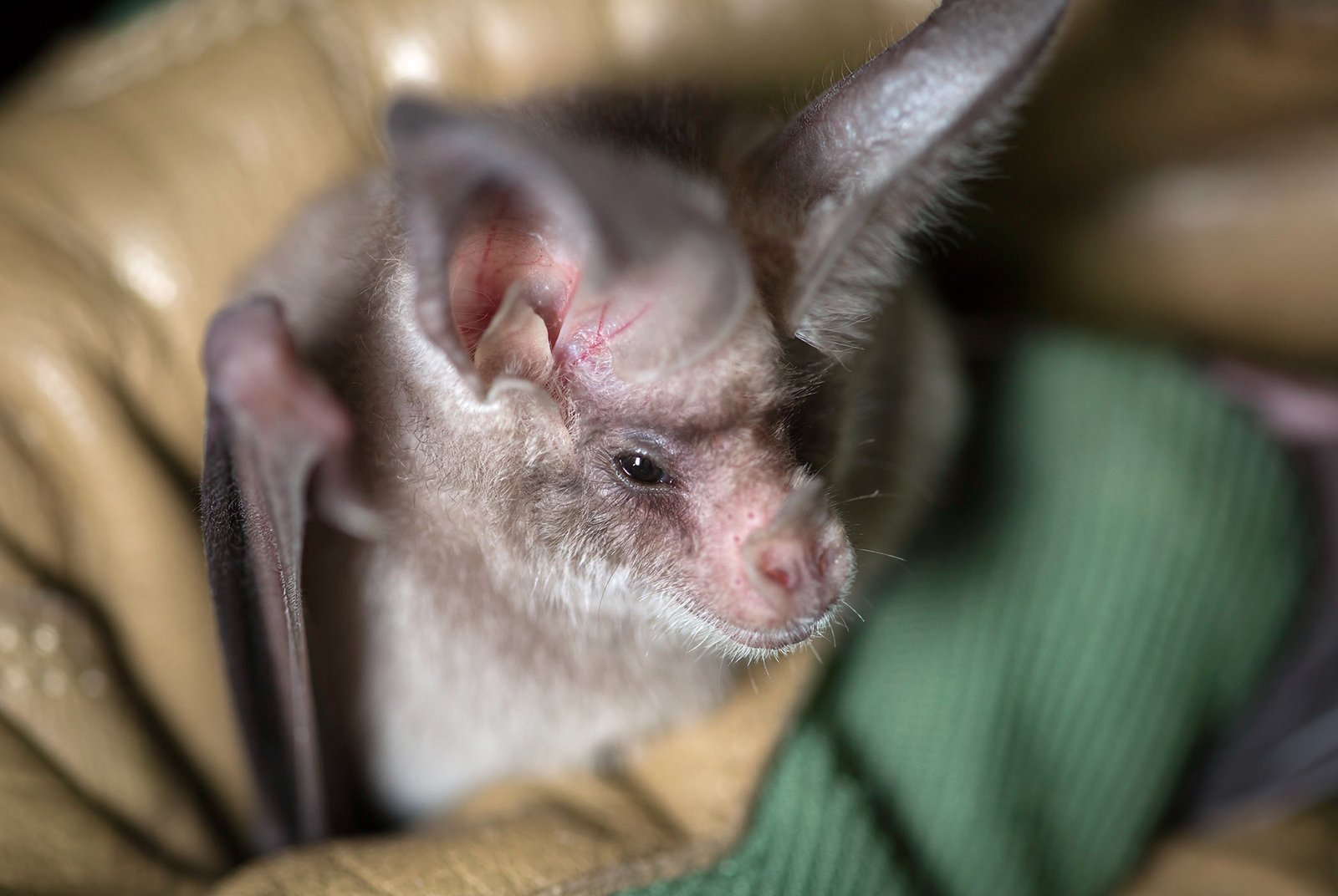California Leaf-Nosed Bat: Macrotus Californicus

The California leaf-nosed bat (Macrotus californicus, MACA) is an insectivorous bat known to occur in the American southwest (southern California, Nevada, and Arizona) and western Mexico’s Mojave, Sonoran, and Colorado deserts. MACA often roosts near the roost opening, where there is some degree of illumination, in cave and mine characteristics. 1Go To Source webcms.pima.gov -“California leaf-nosed bat”
Learn More: Cold Climate Bats
Description Of California Leaf-Nosed Bats
Macrotus californicus, the California Leaf Nosed Bat, is known as Murciélago Orejón Califoriano de Nariz Foliforme in Mexico. This species is considered a large bat and is a member of the bat family Phyllostomidae, known as muerciélagos in Mexico. The California Leaf Nosed Bat is brown in color and is named after the skin protruding from the nose with a triangular fleshy growth.
The sexes are similar in size and appearance, weighing between 12 and 20 grams; they have wingspans of 12 inches, body lengths of 2.4 inches, and large ears over 1 inch in length.
They have large eyes and short and wide wings, making them one of the most maneuverable bats in flight. Their hearing is so good that a cricket’s footsteps can be heard. 2Go To Source mexican-fish.com -“California Leaf Nosed Bat”
California Leaf-Nosed Bat Habitat
Day roosts are generally located in deep mine tunnels or caves, sometimes in buildings or bridges. The preferred roost will provide shelter from heat and aridity. The temperature in one roost was 84 °F, while the temperature outside was 110 °F, and there was always more than 50 percent relative humidity.
Preferred roosts have high ceilings and adequate flight space. Usually, depending on the temperature, these bats may be found hanging by their feet 30-80 ft from the entrance. In buildings, mines, bridges, rock shelters, or other sites with overhead protection, night roosts may be present. These bats are often found in large groups and have a high level of ammonia tolerance. 3Go To Source nrm.dfg.ca.gov -“CALIFORNIA LEAF-NOSED BAT Macrotus californicus “
California Leaf-Nosed Bat Species Range
The California leaf-nosed bat occurs in Arizona, south of the Mogollon Plateau in the Sonoran desert scrub. This species also varies from southern California, southern Nevada, throughout the southwestern half of Arizona, southward throughout Sonora, northern Sinaloa, and southwestern Chihuahua, Mexico, to the southern tip of Baja California.
Behavior Of The California Leaf-Nosed Bat
These bats are active all year and do not migrate or hibernate. This species’ members are nocturnal, usually emerging during the summer 90-120 minutes after sunset, returning to their roost about an hour before sunrise.
California Leaf-Nosed Bat Reproduction
Most males form distinct colonies close to female groups of around 100-500 members during the summer. However, within the female colony, a handful of dominant males stay and have harem groups consisting of 5-25 women and young people.
In the fall, mating takes place. The embryo develops extremely slowly for the first several months of gestation. In spring, development accelerates, and young bats are born in June. 4Go To Source animaldiversity.org -“Macrotus californicus California leaf-nosed bat”
Diet Of California Leaf-Nosed Bats
Leaf-nosed bats consume various insects such as crickets, some beetles, grasshoppers, katydids, June beetles, diving beetles, sphinx, and other moth types. In-flight or off of foliage of the earth, they will capture prey. They are the only bats known to catch caterpillars in North America and are among the very few insect-eating bats that use cactus fruit to supplement their diets. 5Go To Source desertmuseum.org -” Animal Fact Sheet: California Leaf-nosed bat”
Threats To California Leaf-Nosed Bats
Human entry into the mine or cave roosts (disturbance may lead to abandonment) and closure or improper gating of mines for hazard reduction or renewed mining are primary threats. The loss of riparian desert habitat has probably also contributed to population declines.
This species could be negatively affected by various forms of pollution, but the impact on the population is unknown. The food resources and habitat of this species may be affected by climate change, but the probable severity of this threat over the next 10 years or three generations is uncertain. 6Go To Source explorer.natureserve.org -“Macrotus californicus California Leaf-nosed Bat”
Sources:
- “California Leaf-Nosed Bat – Pima County.” Pima County, Pima County Arizona, webcms.pima.gov/cms/one.aspx?portalId=169&pageId=571800. Accessed 15 Jan. 2021.
- “California Leaf Nosed Bat.” Mexico – Fish, Birds, Crabs, Marine Life, Shells and Terrestrial Life, Mexican-fish.com, mexican-fish.com/california-leaf-nosed-bat. Accessed 15 Jan. 2021.
- Harris, J. “CALIFORNIA LEAF-NOSED BAT Macrotus Californicus.” California Department Of Fish And WIldlife, State of California, nrm.dfg.ca.gov/FileHandler.ashx?DocumentID=2311. Accessed 15 Jan. 2021.
- Abbott, S. 2002. “Macrotus californicus” (On-line), Animal Diversity Web. Accessed January 15, 2021 at https://animaldiversity.org/accounts/Macrotus_californicus/
- “California Leaf-Nosed Bat Fact Sheet.” Arizona-Sonora Desert Museum, Arizona-Sonora Desert Museum, www.desertmuseum.org/kids/bats/california_leaf_nosed_bat.php. Accessed 15 Jan. 2021.
- “NatureServe Explorer 2.0.” NatureServe Explorer, NatureServe, explorer.natureserve.org/Taxon/ELEMENT_GLOBAL.2.100867/Macrotus_californicus. Accessed 15 Jan. 2021.
